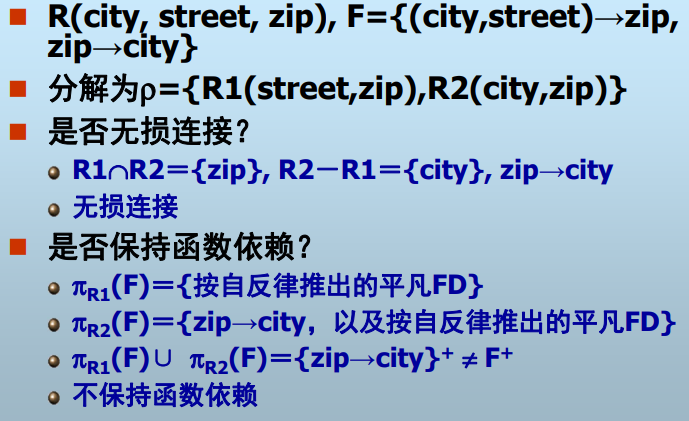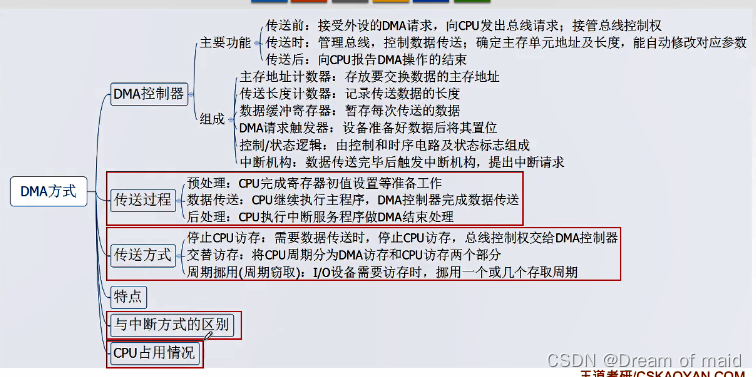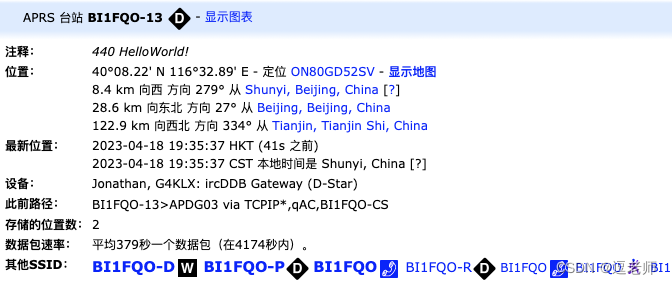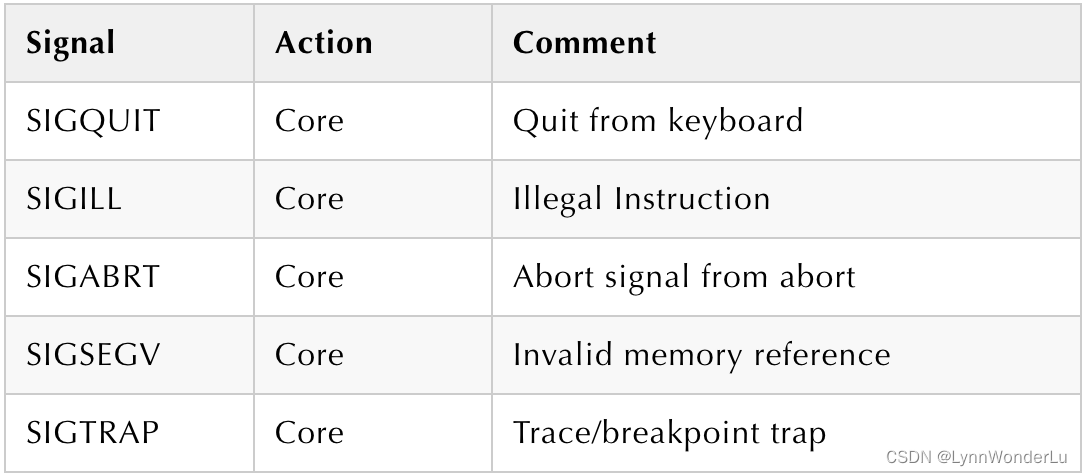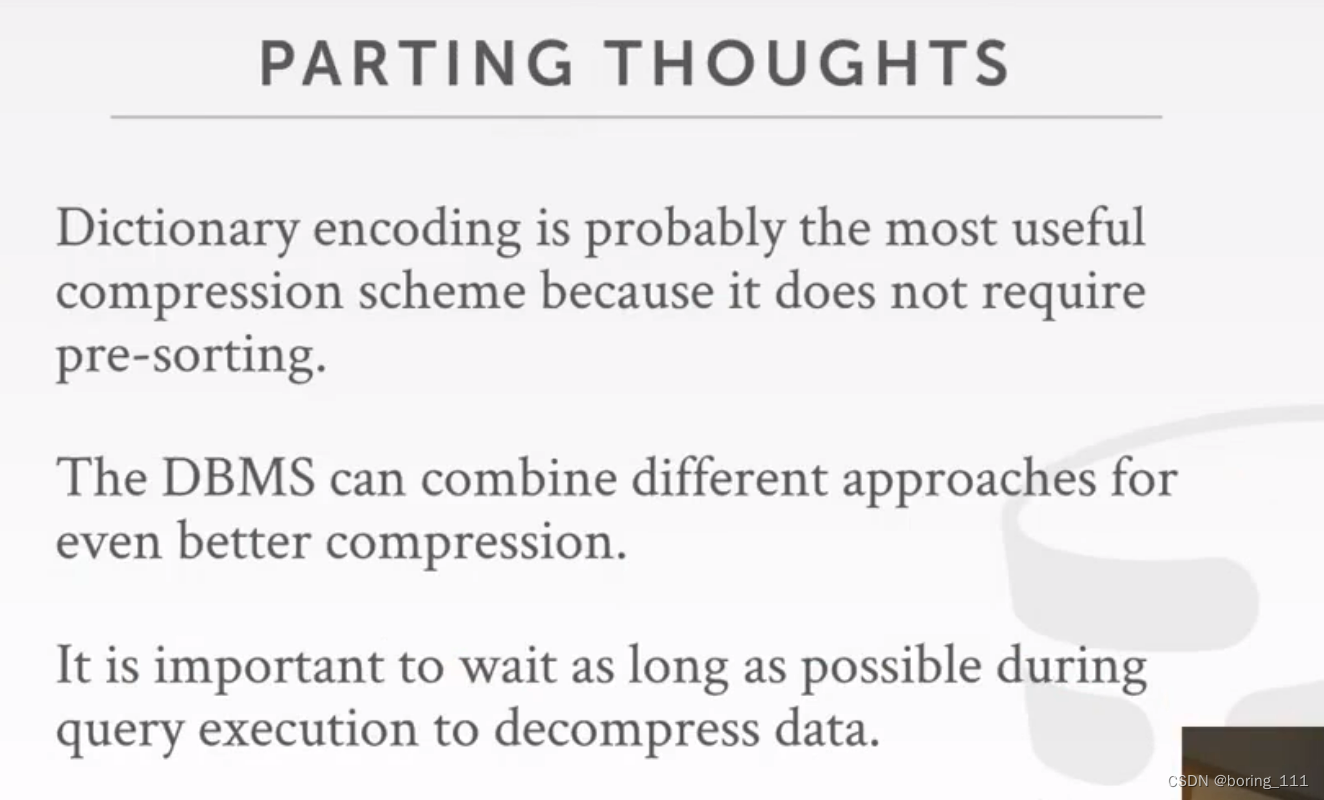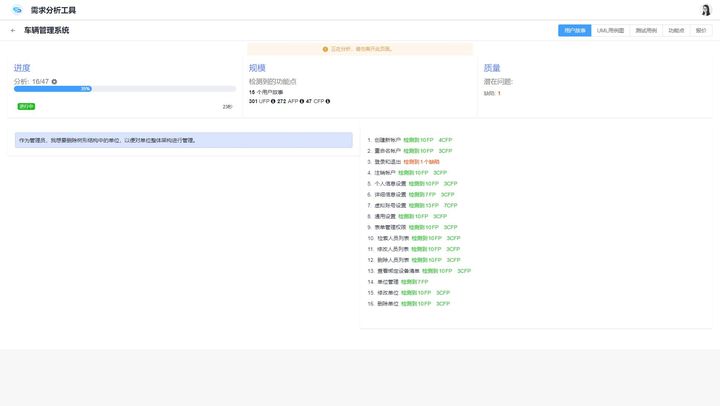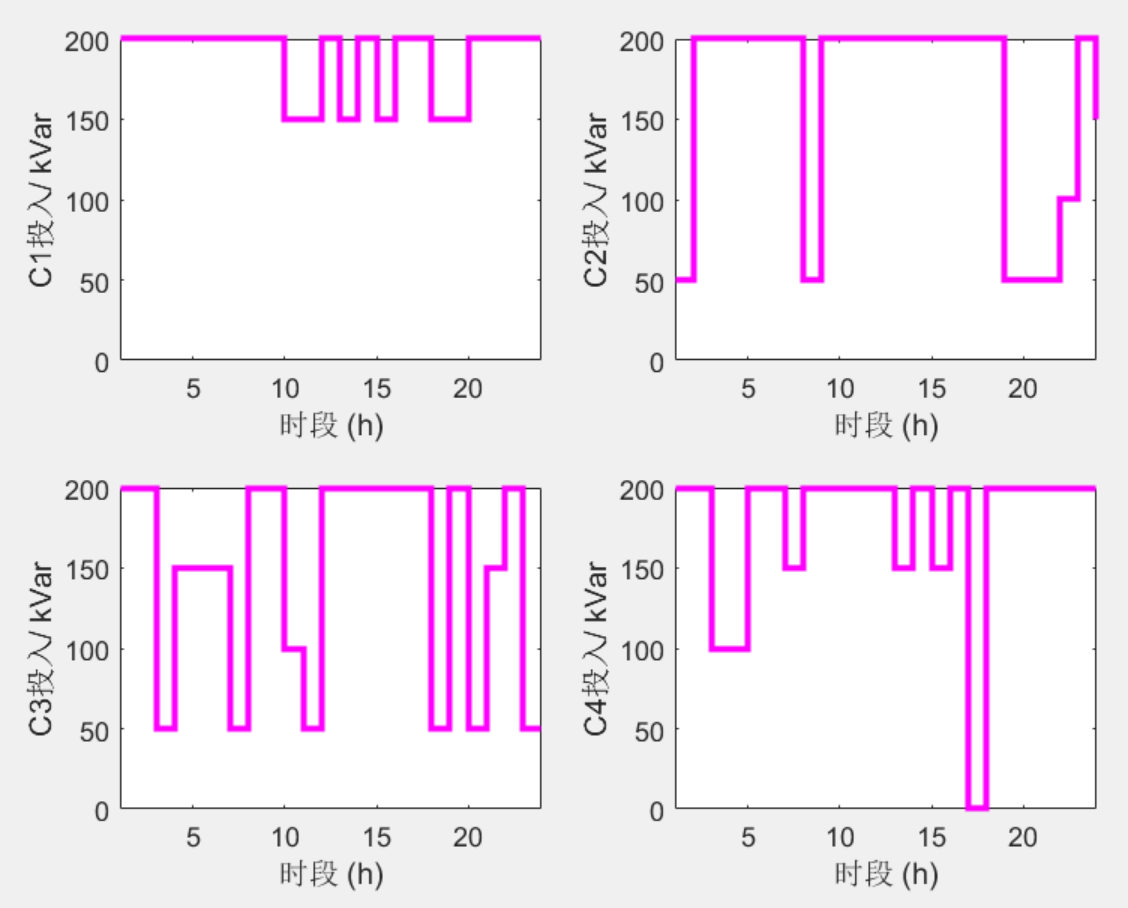文章目录
- 🌷 1. 数据库约束
- ⭐ 1.1 约束类型
- ⭐ 1.2 NULL约束
- ⭐ 1.3 UNIQUE:唯一约束
- ⭐ 1.4 DEFAULT:默认值约束
- ⭐ 1.5 PRIMARY KEY:主键约束
- ⭐ 1.6 FOREIGN KEY:外键约束
- ⭐ 1.7 CHECK约束(了解)
- 🌷 2. 表的设计
- ⭐ 2.1 一对一
- ⭐ 2.2 一对多
- ⭐ 2.3 多对多
- 🌷 3. 新增
- 🌷 4. 查询
- ⭐ 4.1 聚合查询
- 🍁 4.1.1 聚合函数
- 🍁 4.1.2 GROUP BY子句
- 🍁 4.1.3 HAVING
- ⭐ 4.2 联合查询
- 🍁 4.2.1 内连接
- 🍁 4.2.2 外连接
- 🍁4.2.3 自连接
- 🍁4.2.4 子查询
- 1. [NOT] IN关键字
- 2. [NOT] EXISTS关键字:
- 🍁 4.2.5 合并查询
🌷 1. 数据库约束
⭐ 1.1 约束类型
NOT NULL- 指示某列不能存储 NULL 值。
UNIQUE- 保证某列的每行必须有唯一的值。
DEFAULT- 规定没有给列赋值时的默认值。
PRIMARY KEY- NOT NULL 和 UNIQUE的结合。确保某列(或两个列多个列的结合)有唯一标识,有助于更容易更快速地找到表中的一个特定的记录。
FOREIGN KEY- 保证一个表中的数据匹配另一个表中的值的参照完整性。
CHECK- 保证列中的值符合指定的条件。对于MySQL数据库,对CHECK子句进行分析,但是忽略CHECK子句。
⭐ 1.2 NULL约束
创建表时,可以指定某列不为空:
-- 重新设置学生表结构
DROP TABLE IF EXISTS student;
CREATE TABLE student (
id INT NOT NULL,
sn INT,
name VARCHAR(20),
qq_mail VARCHAR(20)
);
⭐ 1.3 UNIQUE:唯一约束
指定sn列为唯一的、不重复的:
-- 重新设置学生表结构
DROP TABLE IF EXISTS student;
CREATE TABLE student (
id INT NOT NULL,
sn INT UNIQUE,
name VARCHAR(20),
qq_mail VARCHAR(20)
);
⭐ 1.4 DEFAULT:默认值约束
指定插入数据时,name列为空,默认值unkown:
-- 重新设置学生表结构
DROP TABLE IF EXISTS student;
CREATE TABLE student (
id INT NOT NULL,
sn INT UNIQUE,
name VARCHAR(20) DEFAULT 'unkown',
qq_mail VARCHAR(20)
);
⭐ 1.5 PRIMARY KEY:主键约束
指定id列为主键:
-- 重新设置学生表结构
DROP TABLE IF EXISTS student;
CREATE TABLE student (
id INT NOT NULL PRIMARY KEY,
sn INT UNIQUE,
name VARCHAR(20) DEFAULT 'unkown',
qq_mail VARCHAR(20)
);
对于整数类型的主键,常配搭自增长auto_increment来使用。插入数据对应字段不给值时,使用最大
值+1。
-- 主键是 NOT NULL 和 UNIQUE 的结合,可以不用 NOT NULL
id INT PRIMARY KEY auto_increment,
⭐ 1.6 FOREIGN KEY:外键约束
外键用于关联其他表的主键或唯一键,语法:
foreign key (字段名) references 主表(列)
案例:
创建班级表 classes,id为主键:
-- 创建班级表,有使用MySQL关键字作为字段时,需要使用``来标识
DROP TABLE IF EXISTS classes;
CREATE TABLE classes (
id INT PRIMARY KEY auto_increment,
name VARCHAR(20),
`desc` VARCHAR(100)
);

创建学生表student,一个学生对应一个班级,一个班级对应多个学生。使用id为主键,classes_id为外键,关联班级表id
-- 重新设置学生表结构
DROP TABLE IF EXISTS student;
create table student (
id int primary key auto_increment,
sn int unique,
name varchar(255) default 'unkown',
qq_mail VARCHAR(20),
classes_id int,
FOREIGN KEY (classes_id) REFERENCES classes(id)
);

⭐ 1.7 CHECK约束(了解)
MySQL使用时不报错,但忽略该约束:
drop table if exists test_user;
create table test_user (
id int,
name varchar(20),
sex varchar(1),
check (sex ='男' or sex='女')
);
🌷 2. 表的设计
三大范式:
⭐ 2.1 一对一
(1)用一张表把所有的字段全部包含里起
user (id, name, account name, password)
(2)按业务把相关的字段拆分出两张表,再为两张表建立主外键关系
user (id, name, account id)
aaccount(id, account name, password);
⭐ 2.2 一对多
对于多的一方,可以和主表建立主外键关系
如学生与班级的关系:

对于多的一方,可以和主表建立主外键关系:
student(id, name, classed_id);
class(id,name);
⭐ 2.3 多对多
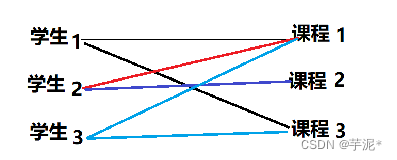
对于多对多关系,可以新建一张关系记录每条数据的关联关系
student(id,name);
course(id,name);
score(id,score,student_id,course_id);
🌷 3. 新增
插入查询结果
语法:
INSERT INTO table_name [(column [, column ...])] SELECT ...
案例:
创建一张用户表,设计有name姓名、email邮箱、sex性别、mobile手机号字段。需要把已有的学生数据复制进来,可以复制的字段为name、qq_mail
-- 创建用户表
DROP TABLE IF EXISTS test_user;
create table test_user (
id INT primary key,
name VARCHAR(20) comment '姓名',
age INT comment '年龄',
email VARCHAR(20) comment '邮箱',
sex varchar(1) comment '性别',
mobile varchar(20) comment '手机号'
);
-- 将学生表中的所有数据复制到用户表
insert test_user(name,email) select name,qq_mail from student;

🌷 4. 查询
⭐ 4.1 聚合查询
🍁 4.1.1 聚合函数
常见的统计总数、计算平局值等操作,可以使用聚合函数来实现,常见的聚合函数有:
| 函数 | 说明 |
|---|---|
COUNT([DISTINCT] expr) | 返回查询到的数据的 数量 |
SUM([DISTINCT] expr) | 返回查询到的数据的 总和,不是数字没有意义 |
AVG([DISTINCT] expr) | 返回查询到的数据的 平均值,不是数字没有意义 |
MAX([DISTINCT] expr) | 返回查询到的数据的 最大值,不是数字没有意义 |
MIN([DISTINCT] expr) | 返回查询到的数据的 最小值,不是数字没有意义 |
案例:
-- 统计班级共有多少同学
select count(*)from student;
-- 统计班级收集的 qq_mail 有多少个,qq_mail 为 NULL 的数据不会计入结果
select count(qq_mail) from student where qq_mail != null;
-- 统计数学成绩总分
select sum(math) from exam;
-- 不及格同学的数学成绩,没有结果,返回 NULL
select sum(math) from exam where math < 60;
-- 统计平均总分
select avg(chinese + math + english) from exam;
-- 返回英语最高分
select max(english) from exam;
-- 返回 > 70 分以上的数学最低分
select min(math) from exam where math > 70;
🍁 4.1.2 GROUP BY子句
SELECT 中使用 GROUP BY 子句可以对指定列进行分组查询。(按group by 中的字段分组查询)
需要满足:使用 GROUP BY 进行分组查询时,SELECT 指定的字段必须是“分组依据字段”,其他字段若想出现在SELECT 中则必须包含在聚合函数中。
select column1, sum(column2), .. from table group by column1;
案例:
准备测试表及数据:职员表,有id(主键)、name(姓名)、role(角色)、salary(薪水)
CREATE TABLE `emp` (
`id` int NOT NULL AUTO_INCREMENT,
`name` varchar(20) NOT NULL,
`role` varchar(20) NOT NULL,
`salary` decimal(11,2) DEFAULT NULL,
PRIMARY KEY (`id`)
);
insert into emp(name, role, salary) values
('马云','服务员', 1000.20),
('马化腾','游戏陪玩', 2000.99),
('孙悟空','游戏角色', 999.11),
('猪无能','游戏角色', 333.5),
('沙和尚','游戏角色', 700.33),
('隔壁老王','董事长', 12000.66);
-- 查询每个角色的最高工资、最低工资和平均工资:
select role,max(salary),min(salary),avg(salary) from emp group by role;

🍁 4.1.3 HAVING
GROUP BY 子句进行分组以后,需要对分组结果再进行条件过滤时,需要用 HAVING语句。
为什么不能使用 WHERE 语句?
MYSQL语句的执行顺序:from -> where -> select -> group by
--显示平均工资低于1500的角色和它的平均工资
select role,max(salary),min(salary),avg(salary) from emp group by role having avg(salary) < 1500;
select role,avg(salary) from emp where salary < 1500 group by role;

⭐ 4.2 联合查询
实际开发中往往数据来自不同的表,所以需要多表联合查询。多表查询是对多张表的数据取笛卡尔积。
准备测试数据:
CREATE TABLE `classes` (
`id` int NOT NULL AUTO_INCREMENT,
`name` varchar(20) DEFAULT NULL,
`desc` varchar(100) DEFAULT NULL,
PRIMARY KEY (`id`)
);
CREATE TABLE `student` (
`id` int NOT NULL AUTO_INCREMENT,
`sn` int DEFAULT NULL,
`name` varchar(255) DEFAULT 'unkown',
`qq_mail` varchar(20) DEFAULT NULL,
`classes_id` int DEFAULT NULL,
PRIMARY KEY (`id`),
UNIQUE KEY `sn` (`sn`),
KEY `classes_id` (`classes_id`),
CONSTRAINT `student_ibfk_1` FOREIGN KEY (`classes_id`) REFERENCES `classes` (`id`)
);
CREATE TABLE `score` (
`id` int NOT NULL AUTO_INCREMENT,
`score` decimal(3,1) DEFAULT NULL,
`student_id` int DEFAULT NULL,
`course_id` int DEFAULT NULL,
PRIMARY KEY (`id`),
KEY `student_id` (`student_id`),
KEY `course_id` (`course_id`),
CONSTRAINT `score_ibfk_1` FOREIGN KEY (`student_id`) REFERENCES `student` (`id`),
CONSTRAINT `score_ibfk_2` FOREIGN KEY (`course_id`) REFERENCES `course` (`id`)
)
insert into classes(name, `desc`) values
('计算机系2019级1班', '学习了计算机原理、C和Java语言、数据结构和算法'),
('中文系2019级3班','学习了中国传统文学'),
('自动化2019级5班','学习了机械自动化');
insert into student(sn, name, qq_mail, classes_id) values
('09982','黑旋风李逵','xuanfeng@qq.com',1),
('00835','菩提老祖',null,1),
('00391','白素贞',null,1),
('00031','许仙','xuxian@qq.com',1),
('00054','不想毕业',null,1),
('51234','好好说话','say@qq.com',2),
('83223','tellme',null,2),
('09527','老外学中文','foreigner@qq.com',2);
insert into course(name) values
('Java'),('中国传统文化'),('计算机原理'),('语文'),('高阶数学'),('英文');
insert into score(score, student_id, course_id) values
-- 黑旋风李逵
(70.5, 1, 1),(98.5, 1, 3),(33, 1, 5),(98, 1, 6),
-- 菩提老祖
(60, 2, 1),(59.5, 2, 5),
-- 白素贞
(33, 3, 1),(68, 3, 3),(99, 3, 5),
-- 许仙
(67, 4, 1),(23, 4, 3),(56, 4, 5),(72, 4, 6),
-- 不想毕业
(81, 5, 1),(37, 5, 5),
-- 好好说话
(56, 6, 2),(43, 6, 4),(79, 6, 6),
-- tellme
(80, 7, 2),(92, 7, 6);
🍁 4.2.1 内连接
语法:
select 字段 from 表1 别名1 [inner] join 表2 别名2 on 连接条件 and 其他条件;
select 字段 from 表1 别名1,表2 别名2 where 连接条件 and 其他条件;
案例:
(1)查询“许仙”同学的 成绩
select sco.score from student stu inner join score sco on stu.id=sco.student_id
and stu.name='许仙';
-- 或者
select sco.score from student stu, score sco where stu.id=sco.student_id and
stu.name='许仙';
(2)查询所有同学的总成绩,及同学的个人信息
-- 成绩表对学生表是多对1关系,查询总成绩是根据成绩表的同学id来进行分组的
SELECT stu.sn,stu.NAME,stu.qq_mail,sum( sco.score )
FROM student stu
JOIN score sco ON stu.id = sco.student_id
GROUP BY sco.student_id;
(3)查询所有同学的成绩,及同学的个人信息:
-- 查询出来的都是有成绩的同学,“老外学中文”同学 没有显示
select * from student stu join score sco on stu.id=sco.student_id;
-- 学生表、成绩表、课程表3张表关联查询
SELECT stu.id,stu.sn,stu.NAME,stu.qq_mail,sco.score,sco.course_id,cou.NAME
FROMstudent stu
JOIN score sco ON stu.id = sco.student_id
JOIN course cou ON sco.course_id = cou.id
ORDER BY stu.id;
🍁 4.2.2 外连接
外连接分为左外连接和右外连接。如果联合查询,左侧的表完全显示我们就说是左外连接;右侧的表完全显示我们就说是右外连接。(左外连接是以左边的表为基准,右边的表没有的数据用null填充)
语法:
– 左外连接,表1完全显示
select 字段名 from 表名1 left join 表名2 on 连接条件;
– 右外连接,表2完全显示
select 字段 from 表名1 right join 表名2 on 连接条件;
案例:
查询所有同学的成绩,及同学的个人信息,如果该同学没有成绩,也需要显示
-- 左外连接,表1完全显示
select 字段名 from 表名1 left join 表名2 on 连接条件;
-- 右外连接,表2完全显示
select 字段 from 表名1 right join 表名2 on 连接条件;
案例:查询所有同学的成绩,及同学的个人信息,如果该同学没有成绩,也需要显示
-- “老外学中文”同学 没有考试成绩,也显示出来了
select * from student stu left join score sco on stu.id=sco.student_id;
-- 对应的右外连接为:
select * from score sco right join student stu on stu.id=sco.student_id;
-- 学生表、成绩表、课程表3张表关联查询
SELECT stu.id,stu.sn,stu.NAME,stu.qq_mail,sco.score,sco.course_id,cou.NAME
FROM student stu
LEFT JOIN score sco ON stu.id = sco.student_id
LEFT JOIN course cou ON sco.course_id = cou.id
ORDER BY stu.id;
🍁4.2.3 自连接
自连接是指在同一张表连接自身进行查询。
案例:
显示所有“计算机原理”成绩比“Java”成绩高的成绩信息
-- 先查询“计算机原理”和“Java”课程的id
select id,name from course where name='Java' or name='计算机原理';
-- 再查询成绩表中,“计算机原理”成绩比“Java”成绩 好的信息
SELECT s1.* FROM score s1,score s2
WHERE
s1.student_id = s2.student_id
AND s1.score < s2.score
AND s1.course_id = 1
AND s2.course_id = 3;
-- 也可以使用join on 语句来进行自连接查询
SELECT s1.* FROM score s1
JOIN score s2 ON s1.student_id = s2.student_id
AND s1.score < s2.score
AND s1.course_id = 1
AND s2.course_id = 3;
以上查询只显示了成绩信息,并且是分布执行的。要显示学生及成绩信息,并在一条语句显示:
SELECT stu.*,s1.score Java,s2.score 计算机原理
FROM score s1
JOIN score s2 ON s1.student_id = s2.student_id
JOIN student stu ON s1.student_id = stu.id
JOIN course c1 ON s1.course_id = c1.id
JOIN course c2 ON s2.course_id = c2.id
AND s1.score < s2.score
AND c1.NAME = 'Java'
AND c2.NAME = '计算机原理';
🍁4.2.4 子查询
子查询是指嵌入在其他sql语句中的select语句,也叫嵌套查询
单行子查询:返回一行记录的子查询
查询与“不想毕业” 同学的同班同学:
select * from student where classes_id=(select classes_id from student where name='不想毕业');
多行子查询:返回多行记录的子查询
案例:查询“语文”或“英文”课程的成绩信息
1. [NOT] IN关键字
-- 使用IN
select * from score where course_id in (select id from course where
name='语文' or name='英文');
-- 使用 NOT IN
select * from score where course_id not in (select id from course where
name!='语文' and name!='英文');
可以使用多列包含:
-- 插入重复的分数:score, student_id, course_id列重复
insert into score(score, student_id, course_id) values
-- 黑旋风李逵
(70.5, 1, 1),(98.5, 1, 3),
-- 菩提老祖
(60, 2, 1);
-- 查询重复的分数
SELECT * FROM score
WHERE
( score, student_id, course_id ) IN ( SELECT score, student_id,
course_id FROM score GROUP BY score, student_id, course_id HAVING
count( 0 ) > 1 );
2. [NOT] EXISTS关键字:
-- 使用 EXISTS
select * from score sco where exists (select sco.id from course cou
where (name='语文' or name='英文') and cou.id = sco.course_id);
-- 使用 NOT EXISTS
select * from score sco where not exists (select sco.id from course cou
where (name!='语文' and name!='英文') and cou.id = sco.course_id);
在from子句中使用子查询:子查询语句出现在from子句中。这里要用到数据查询的技巧,把一个子查询当做一个临时表使用。
查询所有比“中文系2019级3班”平均分高的成绩信息:
-- 获取“中文系2019级3班”的平均分,将其看作临时表
SELECT avg( sco.score ) score
FROM score sco
JOIN student stu ON sco.student_id = stu.id
JOIN classes cls ON stu.classes_id = cls.id
WHERE cls.NAME = '中文系2019级3班';
查询成绩表中,比以上临时表平均分高的成绩:
SELECT *
FROM score sco,
(
SELECT avg( sco.score ) score FROM score sco
JOIN student stu ON sco.student_id = stu.id
JOIN classes cls ON stu.classes_id = cls.id
WHERE
cls.NAME = '中文系2019级3班'
) tmp
WHERE sco.score > tmp.score;
🍁 4.2.5 合并查询
在实际应用中,为了合并多个select的执行结果,可以使用集合操作符 union,union all。使用UNION和UNION ALL时,前后查询的结果集中,字段需要一致。
union
该操作符用于取得两个结果集的并集。当使用该操作符时,会自动去掉结果集中的重复行。
案例:查询id小于3,或者名字为“英文”的课程:
select * from course where id < 3
union
select * from course where name='英文';
-- 或者使用or来实现
select * from course where id < 3 or name='英文';
union all
该操作符用于取得两个结果集的并集。当使用该操作符时,不会去掉结果集中的重复行。
案例:查询id小于3,或者名字为“Java”的课程
- 可以看到结果集中出现重复数据Java
select * from course where id<3
union all
select * from course where name='英文';






